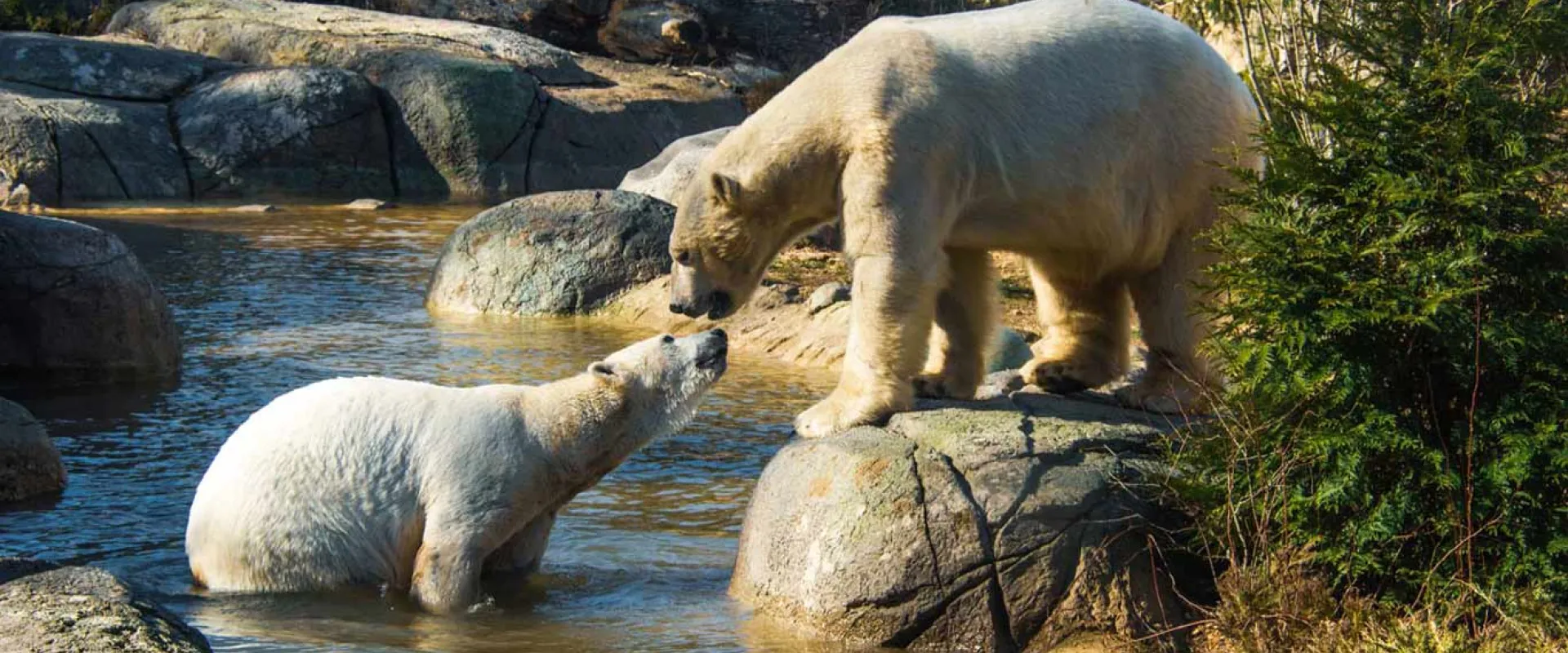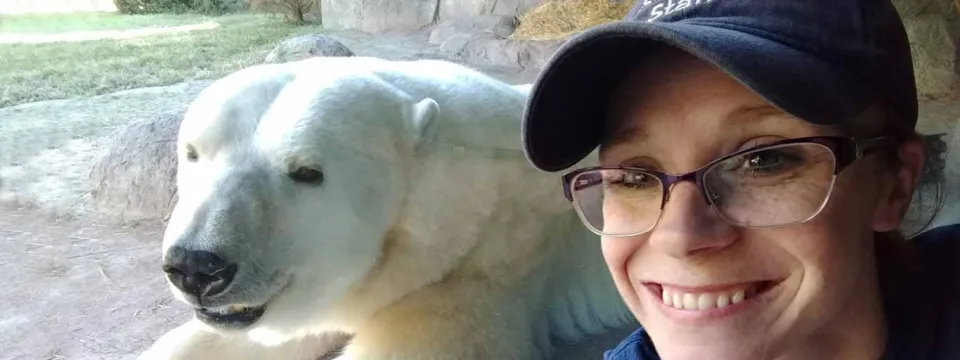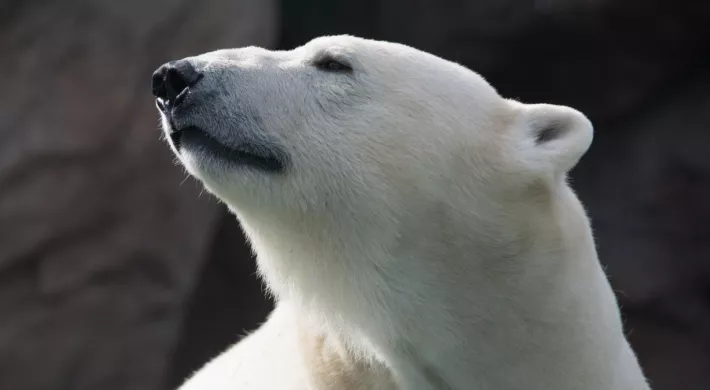Update 2022: Nikita and Anana, unfortunately, never produced a cub, although sparks did fly for the couple; Nikita moved to Utah's Hogle Zoo to breed with another female in hopes of an offspring. Male polar bear Payton moved to the North Carolina Zoo as a mate for Anana in 2021. Still no cubs, though!
Written by Nicole Pepo, Zookeeper, North Carolina Zoo
Hello everyone! My name is Nicole Pepo, and I'm a polar bear keeper at the North Carolina Zoo! I've been lucky enough to work at the Zoo for almost 11 years and spent most of my time as part of the Rocky Coast team. The Rocky Coast consists of several habitats replicating the Pacific Northwest and the Arctic, so the animals the team cares for include the polar bears, seals and sea lions, Arctic foxes and sea birds (puffins, murres and auklets).
Pictured Above: Keeper Nicole with Anana
In my years at Rocky Coast, I've had the privilege of knowing quite a few polar bears, but none have been as special to me as the Zoo's current dynamic duo, Nikita and Anana. Nikita (Nik) is our male polar bear (the most handsome), and he is currently 12 years old. He came to us in January of 2016 from the Kansas City Zoo; he was born at the Toledo Zoo in Ohio. Anana is our female (prettiest princess), and she is 20 years old. She came to us from the Lincoln Park Zoo in Chicago in 2014; she was born at the Seneca Park Zoo in New York.
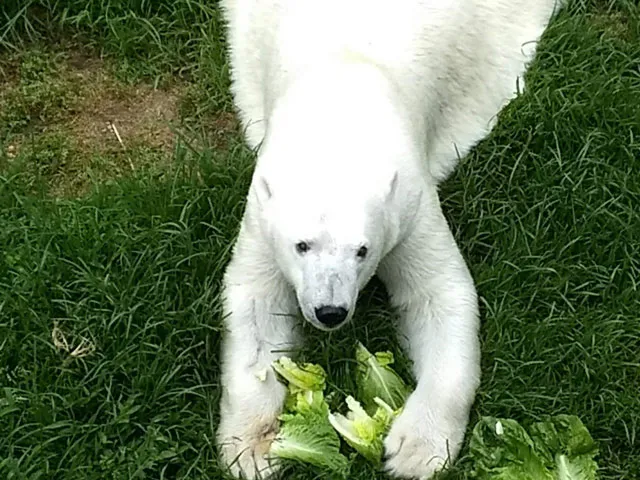
Anana enjoying some romaine lettuce
The North Carolina Zoo is accredited by the Association of Zoos and Aquariums (AZA), and we are a part of great conservation initiatives to help maintain healthy populations of species in both zoos and in the wild. Nik and Anana are at the Zoo based on a breeding recommendation from the polar bear Species Survival Plan (SSP). An SSP is a way to manage genetics within the zoo-based population of a species to maximize the chances of healthy reproduction. Nik and Anana are a good genetic match, and we hope that they'll have some adorable little cubs in the future!
In the wild, polar bears are mostly solitary and only come together for a short time during the breeding season. You might see a mother bear with her cubs or congregations of bears at large carcasses (whales mostly) when food resources are low, but males and females stay separate for most of the year outside of those circumstances, and they like it that way!
Breeding season starts as early as February and runs through May, sometimes even June. Males will actively seek out, track, and protect females hoping they can court her and breed with her while she is cycling. Females will typically cycle for about a week, and the male (if he's not too much of a pest and she chooses to let him hang around) will breed with her while he guards her against any other male polar bears in the area. After the week of courtship and breeding, the male and female go their separate ways.
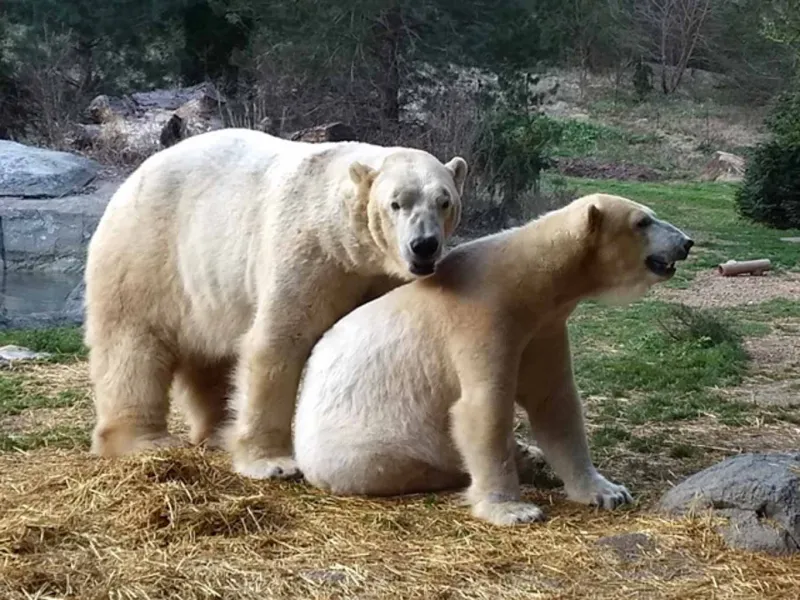
Nikita and Anana showing breeding behavior
As if the social part isn't complicated enough, the females go through what's called "delayed implantation." That means that while breeding happened in late winter or spring, implanting a fertilized embryo won't happen until the fall. The female spends time in between breeding and implantation trying to build up fat reserves in her body to live on while she's denning over the winter. Denning is building a quiet, secluded, and concealed cave in the snow.
If all of the stars align and the lady bear has all of the resources she needs, she will confine herself to the safe den during her cubs' gestation. Moms and cubs stay in the den until the cubs are big enough to keep up with her out in the harsh arctic landscape. While in the den, she doesn't eat, poop, or pee! She rests, conserves her energy, and feeds her cubs. The average litter size is two, and most cubs are born in late November (some are born in December and rarely in January), and they only weigh around 1lb at birth! Mom and cubs typically exit the snow den together in April when mom seeks out food after not having eaten for potentially 5-6 months. Superhero momma bear protects her cubs and shows them how to thrive in the arctic while they grow quickly on her milk that is 31% fat! They'll stay and learn from her for 2-3 years before they can go off and live on their own.
Nik and Anana stick pretty close to the seasonal trends mentioned above, and we strive to keep things as natural as possible for them at the Zoo! We are fortunate enough to have two outdoor habitats and two indoor spaces. All areas connect and can open and close in multiple ways. We play musical bears, shift them throughout the spaces to keep things novel for them and keep them separate outside of breeding season.
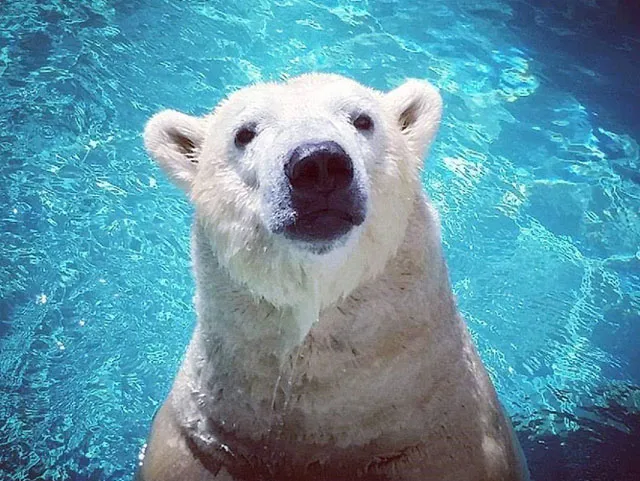
Nikita going for a swim
Anana has a maternity den with an outside yard in one of the indoor spaces where she can den and raise her cub(s) if we are lucky enough to have one someday. Another challenge with polar bear breeding is females go through false pregnancies in both the wild and at the zoo - she will show all the signs of pregnancy but, alas, no cub born.
So all we can do is try to set Nik and Anana up for success and keep our fingers crossed. Phew...polar bear dating is complicated!
Check out my Ask an Expert video below, where I answered the questions you submitted on the Zoo's Instagram story for National Zookeeper Week.
